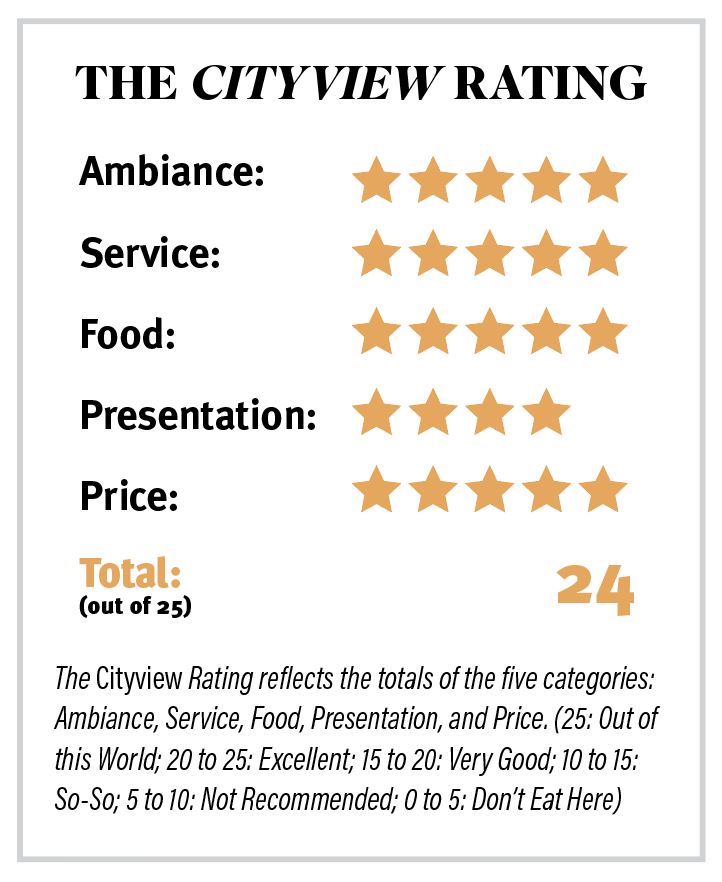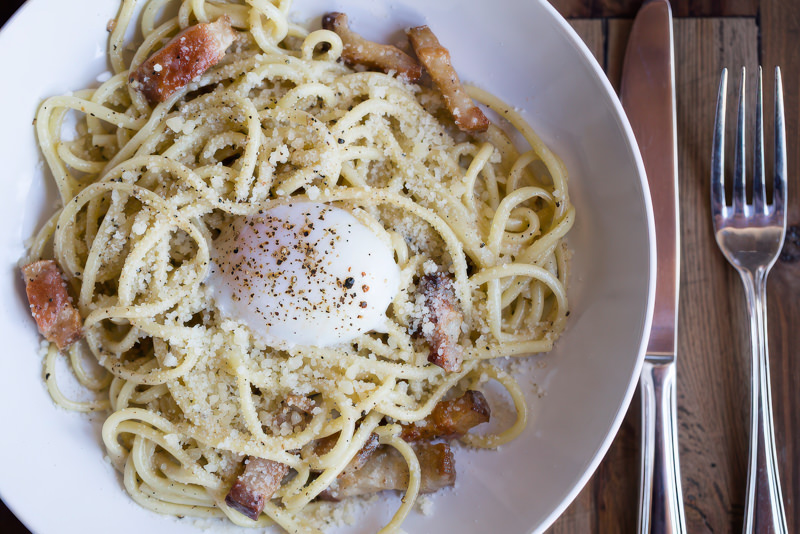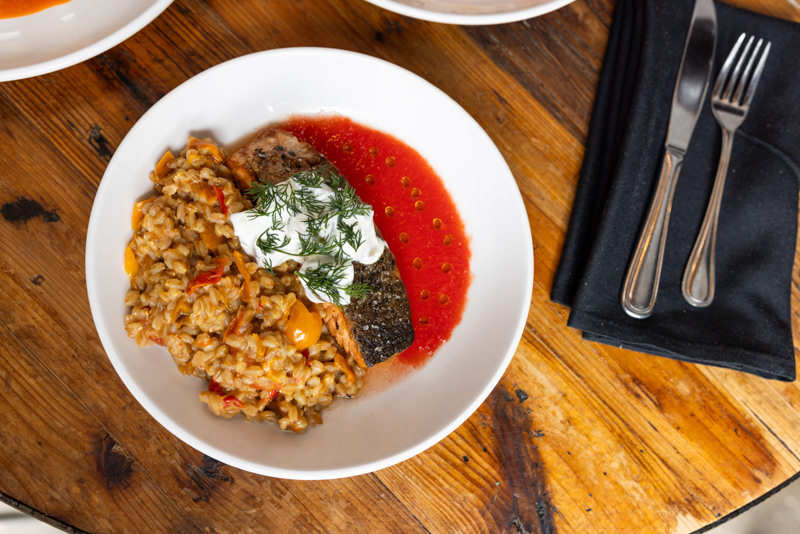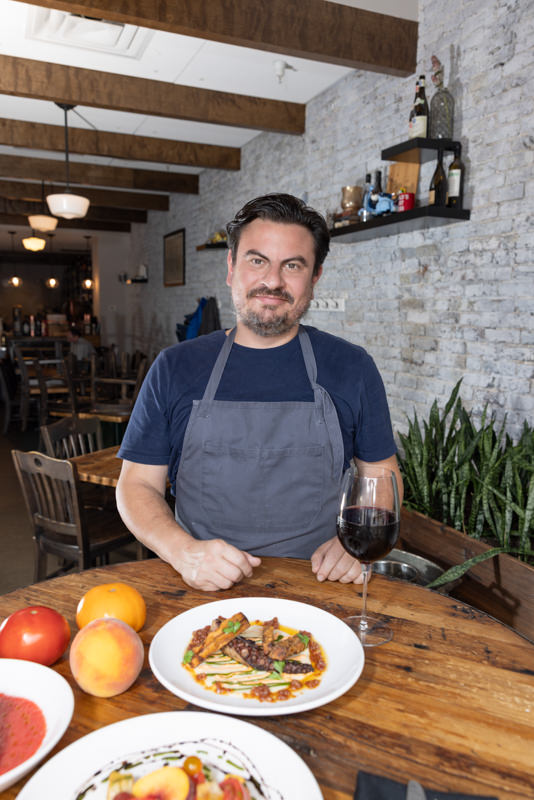An evening at Matt Gallaher’s Market Square rifugio lets the cuisine shine.
There are restaurants that announce themselves with fanfare—brash décor, inflated adjectives, a signature cocktail named after someone’s grandmother. Then there are places like Emilia, which arrive on tiptoe. They settle into the neighborhood not with clamor but with poise, like a houseguest who knows where the wine glasses are kept. You barely notice the moment when the unfamiliar becomes familiar, when a first visit turns into a habit and a menu into a mood.

Emilia, nestled into Knoxville’s Market Square like it has always been there, has the quiet confidence of a place with nothing to prove. That may be because at its helm is chef and owner Matt Gallaher, whose pedigree includes time at Blackberry Farm and the kind of apprenticeship that begins not with Instagram reels but with mise en place and mentorship. His is a kitchen not of gimmicks, but of intention.
The dining room has that clean, contemporary Southern-European aesthetic that says we thought about this, but also you don’t need to. Dark wood, soft lighting, and the welcome hush of a place where conversation is both heard and encouraged.
We began in the capable hands of General Manager and Sommelier Keith Kirk, another Blackberry alum, though “alum” doesn’t quite capture two decades spent among the hills, cellars, and tasting rooms of Tennessee’s most pedigreed kitchens. Kirk’s approach to wine is generous, inquisitive. When we told him we were partial to Grenache from the Rhône but curious about Italy, he returned with a Cannonau di Sardegna Sartiglia, a sardonic, ruby-colored beauty named for a medieval equestrian event. “A cocktail wine,” he called it, a disarming understatement for something with such spine and spice.

The Overture
Grilled Spanish octopus arrived, all char and tenderness, arranged with a light cannellini bean purée, sweet peppers, and whisper-thin eggplant fries. A familiar Mediterranean trope, but here refined. Less the assertive Greek rendition, more the Spanish style: simmered, seared, supple. This is a “do not miss” item.
PEI mussels, those ever-dependable bivalves, were bathed in a fragrant white wine and fennel broth that demanded plenty of bread. Emilia obliged, with house-made focaccia and creamy ricotta from Cruze Farm, both blessedly unshowy. A Caprese salad, meanwhile, was made radiant by the inclusion of local peaches, heirloom tomatoes, and mozzarella pulled in-house. No reinvention, just clarity.
The Middle Movement
The pastas at Emilia deserve an aria of their own. We tried the Mafalde with zucchini alla Nerano, a dish lifted from the Amalfi Coast and transported, deftly, to East Tennessee. This dish, invented on the Sorrento Peninsula and recently promoted from the “secret menu” (more on this later) is a staff and customer favorite. Here, a plant-based broth made from toasted pine nuts and mushrooms coated the ruffled pasta like velvet. A dish that whispers, rather than shouts. It’s no wonder it’s one of Stanley Tucci’s favorite dishes. Another popular item is the Fusilli Carbonara with Benton’s bacon and a poached farm egg.
Then, a classical rendition of Pork Milanese, all crisp edges and yielding center, pounded thin and fried in an “explosive” batter enriched with rice and Pinot Grigio. Over a bed of arugula, and topped with an almost translucent slice of Parmigiano Reggiano, the cutlet was accompanied by a pomodoro sauce that was neither rustic nor coy, just bright, fresh, and confident.
But it was the gnocchi that lingered. Emilia’s Gnocchi Amatriciana may be the finest version of the dish not served by a Roman nonna. The texture: yielding without collapse. The sauce: a chorus of guanciale, Pecorino Romano, white wine, and just enough heat. It’s the sort of dish that risks ruining you for all others.
Pan-roasted Patagonian salmon followed, served over a farro risotto that brought a hushed, grainy comfort to the plate. Dill, grilled cucumber, and sweet potato played off the smoked crème fraiche, lending Scandinavian accents in a Mediterranean conversation. This sustainable salmon may be good for you with all the omega-3 fatty acids, but we weren’t thinking of that as we enjoyed the crispy crust and moist, flaky interior.
To pair with the richer fare, Kirk introduced a Spanna from Piedmont—a Cuvée Bernardo Vallana from Maggiora, near the Swiss border. Spanna, the local name for Nebbiolo, is a grape of terroir. It presents a mid-palate sweetness with notes of red cherry, kirsch, rose petal and cinnamon. Its acidity, vivid and red fruited, sliced through the dish like a witty remark in a heavy conversation.

A Word About the Not-So-Secret Menu
Regulars know that the kitchen is flexible. Pasta can be reconfigured. Children can get their spaghetti and meatballs, no drama. One standby, chicken alfredo, may not be listed, but it’s there, always. A password for the cognoscenti.
One of the charms of Emilia is the clientele. We always seem to see old friends, like Becky Hancock, executive director of the Historic Tennessee Theatre Foundation, dining with a job candidate before presiding over a performance of Les Miserables. “We ought to thank the Tennessee Theatre,” says Kirk. “So many people come here before the shows, and they’ve booked a lot of great ones.”
The Coda
Dessert should be compulsory. The Butterscotch Budino was the unanimous favorite. While a pudding is made with sugar, cornstarch, and milk, budino is thickened with egg yolks. This one is silky, topped with salted caramel, pine-nut crumble, and an unapologetic amount of whipped cream. Pistachio gelato, served as a deconstructed Pavlova, was ethereal and nutty, and arrived looking like a little postmodern sculpture. For the purists: a dark chocolate sorbetto with just enough bite, offset by Amarena cherries and crunch.

A piping hot and fresh espresso offset the richness of the desserts. We are believers in the benefits of espresso as a digestivo. A single shot contains less caffeine than a normal eight-ounce cup of coffee and stimulates the digestive system. Italians drink espresso after dinner to help break down all those delicious pasta dishes. It is consumed without milk because milk takes longer for your stomach to process (and the reason you shouldn’t order a cappuccino after dinner.)
Limoncello, made in-house, was poured to finish. Sharp, clean, and a little sentimental, like the final scene of a favorite film you didn’t expect to love quite so much.
Throughout the evening, Gallaher moved through the dining room like a conductor at rest: present, attentive, but never overbearing. His hospitality is that of someone who learned it not from a playbook but from watching it practiced, carefully, by others. John Fleer at Blackberry Farm trained him that way, and it shows.
Even if you are a regular at Emilia, we recommend you ask the staff for recommendations. They love food, know wines, and are delighted to share what they know to make for a fabulous evening.
Emilia is a restaurant that doesn’t demand your attention but earns your affection. It feels, already, like a place with stories. Go often enough, and you’ll be part of the story, too.

Comments are closed.